Feeding Tropical Fish - Diet
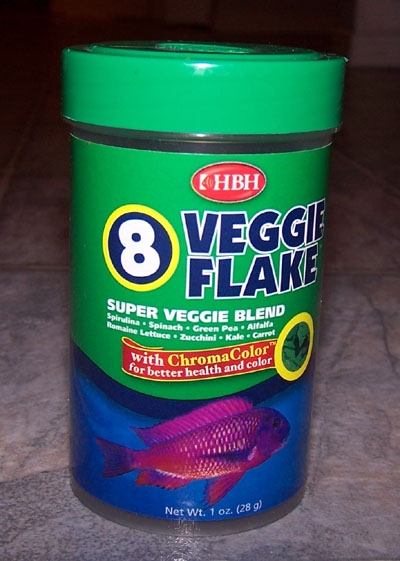
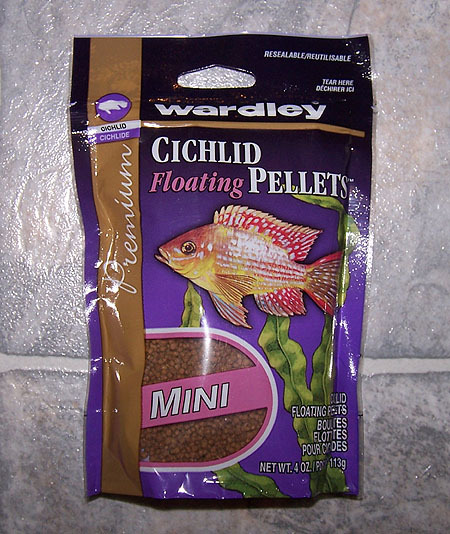
One of the most important aspects of maintaining an aquarium is feeding the fish. They are dependant on your proper care. Most fish eat flake foods, but refer to the Fish Facts tab to get information on specific species and their diets. For example, the African cichlid diet is mainly algae based foods, like spirulina, and they don't require high protein insect based flakes. Feed your fish at least twice a day and try to make sure they finish eating in a couple of minutes. Don't feed all the food at once - spread out the length of the feeding period. Make sure each fish is finding some of the food, including the bottom dwellers. There are two basic situations to watch for:
See more information below about feeding fry.
How Much Should I Feed my Tropical Fish?
How much should you feed your tropical fish? There are two basic situations to watch for:
-
Feeding too much. When fish are no longer hungry, they will ignore further feedings and the food will settle at the bottom and begin to pollute the tank. As long as they are eating all the food, you can increase the number of feedings, but clouded water is a sure sign you have fed them too much and its time for a water change - read the Water Quality section again.
-
Feeding too little. This situation is easy to recognize in the early stages. Your middle & lower level swimmers and your shy fish will come to the top and compete for food - a sure sign that they are starving, because they don't want to be there. Increase the length of time for each feeding or the number of feedings.
Fish can go without food for days at a time, so you can leave them without food on a short vacation. For longer absences you can buy foods that will release in the water for periods of up to a week. If you are having trouble with an ammonia spike, it's a good idea to reduce or stop feeding your fish.
Feeding Tropical Fish - Automatic Fish Feeders
by LittleHippyGirl:
Never use those feeder blocks, there are so many horror stories about those. People usually come back
to polluted water and dead fish. Automatic feeders have their share of horrors too, but much less. If you
really need to buy one, get a high quality brand and test it out for a week before you leave. When you go
on vacation, friends and neighbors are your best bet, just make sure they don't feed them too much and only
every other day. Fish can survive for a long long time with little or no food. I just went on vacation for a
couple weeks and I had my boyfriend take care of my animals and plants. He laughed at me because I left a 2
page letter on specific care and what to do incase of emergency, but almost everyone is fine now...just can't
seem to find my ghost shrimp
![]() I came back
to a sputtering filter though, and figured out the power had gone out like Lemuel said. That filter motor was fried but
luckily I had a spare motor for that model. So yeah, power outages are something to look out for. I hadn't had
one in 2 years so I had forgotten about that.
I came back
to a sputtering filter though, and figured out the power had gone out like Lemuel said. That filter motor was fried but
luckily I had a spare motor for that model. So yeah, power outages are something to look out for. I hadn't had
one in 2 years so I had forgotten about that.
Breeding Tropical Fish - Cichlids
Cichlids often breed on large flat surfaces, such as rocks or the inside of flower pots. The tank should have no plants and the tank should have gravel on the bottom. Mouthbrooders will dig out the gravel and the female will deposit eggs in the depression. The eggs are fertilized and then taken in the mouth until they hatch. Angelfish will deposit eggs against plants, such as amazon swords.
Breeding Tropical Fish - Characins and Barbs
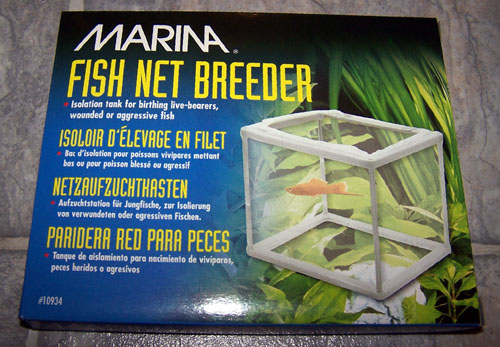
Characin and Barbs breed in thickly planted tanks with no gravel, rocks or flower pots. The best plants are cabomba, hornwort, java moss. Plastic plants work well too. The plants generally fall to the bottom of the tank. Use a flashlight to search for eggs by the reflection. Parents should be removed after breeding. For American Characin the water should be soft, acidic and free of bacteria. The lighting should be very dim for breeding and for hatching the eggs. Separate the pair before breeding and feed them well. Spawning will occur in the morning. Return the pair to the main tank if no breeding occurs within 3 days. The fry can be raising in a breeding net if space is in short supply.
Anabantids require very clean water. The male builds a bubblenest by blowing bubbles that remain at the surface. The pair breeds by wrapping and intertwining. The eggs of Gouramis tend to float, while betta eggs will sink. The male should remain in the breeding tank after breeding, as they will ensure that eggs are placed within the bubbles and they will remove infertile eggs.
Breeding Tropical Fish - Livebearers
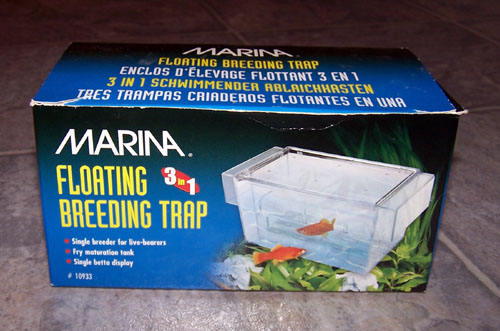
Livebearers breed continuously, often monthly. Females will show a bulging stomach and a dark gravid spot near the anal fin. Females will not eat their newborn, but others will. Floating plants, such as Crystalwort, will give the young places to hide. Breeding traps work very well in ensuring that the young survive.
Breeding Tropical Fish - Anabantids
The above information outlines some of the common breeding characteristics of the major fish families. For information about a single fish, search Tropical Fish Profiles.
Feeding Tropical Fish Fry
Newly hatched fry are usually extremely small in size. They need excellent water quality. Isolating them in a net enclosure keeps them safe from larger fish and can assist in maintaining proper circulation and water quality. Fry need very small sources of food. Live foods produce the best results.
Following are 3 common fry foods: brine shrimp, prepared mixes and infusoria
Feeding Fry - Brine Shrimp

Brine shrimp (Artemia) are a common source of food for fry after they matured beyond the infusoria stage. The brine shrimp must be newly hatched (napulii), so that they are small enough to be eaten. The unhatched eggs, called cysts, can be purchased at pet stores or online. Examples include San Francisco Bay Brand Brine Shrimp Eggs and Ocean Star International Brine Shrimp Eggs.
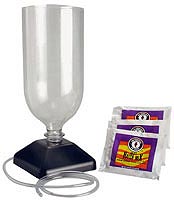
Plastic bottles are often used to hatch brine shrimp. Add one quart of tap water, one tablespoon of coarse salt and two teaspoons of brine shrimp eggs. Aeration should be provided and the temperature should be near 80F (27C). A bright light or a heater can be used to attain the proper temperature. The eggs will hatch in 24 to 36 hours. At this point the aeration should be stopped. The shells will float to the top and the napulii will settle on the bottom. Siphon the napulii from the bottom into a fine mesh net, rinse with freshwater and feed to the fry.
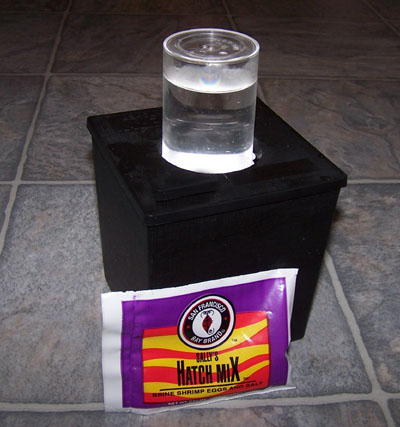
The Shrimpery by San Francisco Bay Brand is an excellent source for making small batches of brine shrimp. Simply add a packet, which contains salt and eggs, to the base. Add water without salt to the clear plastic bottle that mounts on top of this. The brine shrimp hatch without aeration and they swim out of the saltwater into the freshwater that is in the light. You take the clear plastic bottle off and pour the brine shrimp and water into your aquarium. You can replace the water in the clear bottle several times before the brine shrimp stop hatching. We've tested it and it works well!
Feeding Fry - Prepared Mixes
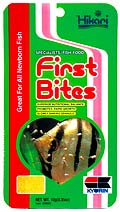
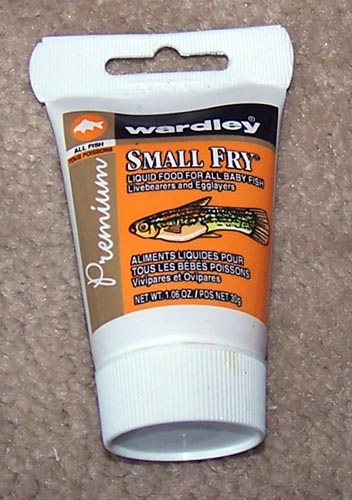
Prepared mixes include flake-based food that has been ground to a fine powder and ingredients suspended in liquids. Examples include Hikari First Bites powder and Wardley�s Small Fry liquid. The problem with prepared mixes is that uneaten portions quickly pollute the water. Since the fry are too small to be in a tank with a filter, the water quality deteriorates and the fry are at risk. Liquid mixes also tend to settle at the bottom, while young fry tend to search for food on the sides and top of the tank. Live foods produce better results. If you use prepared foods with newly hatched fry, use a baster to remove rotting food from the bottom of the tank several times a day. Also, remove pollution from the surface by using a small cup. Pour the polluted water into a cup and search for fry that you may have mistakenly removed. You can use a baster to suck them up and return them to their tank.
Feeding Fry - Infusoria
Infusoria is a generic term for various microorganisms that are present in water, but can't be seen without a microscope. A specific example would be Protozoa. Infusoria feed on bacteria and are already present in low levels in an aquarium. The trick is to grow enough to supply young fry. If you have access to pond water, this will suffice. If you don't, take some water from an established tank and add some plant material, such as lettuce or potato. Meat can be used too, but the smell is much worse. Place the mixture in a sunny location for a couple of days. The water will become cloudy and smelly as bacteria develop. The infusoria will increase in numbers as they feed on the bacteria and the water will begin to clear. Aeration will assist the process. An eye dropper or baster can be used to move the infusoria to the tank with the newborn fry. Be careful as the water can foul to the point it is toxic and some sources indicate the micro-organisms can be harmful.